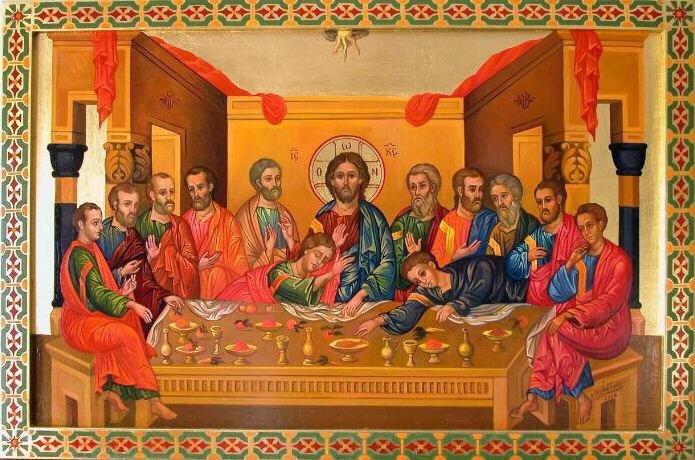TOPIC: Theology of Liturgy
By Len Mier
Thy Kingdom Come: Social Justice and Salvific Outlook in the Anaphora of St. Basil the Great
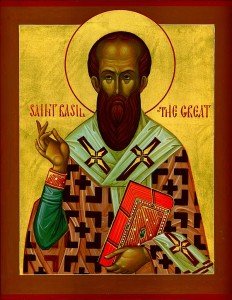
Liturgy literally means “the work of the people” in the view of Christian worship of God. It can also be taken to mean “public service” in secular terms as the view of ancient Athenian culture. The second meaning seems to have no connection to the first meaning until you start to look at the thought processes of the Cappadocian Fathers and the social justice homilies of St Basil the Great. Once you connect the thoughts of St Basil and look at the Basilian Anaphora you can see that liturgy is the work of the people to praise God and of the called to a life of service to one’s neighbor, transforming the worshiper into the same kind of being that they are worshiping.
The ancient world view on care for the poor
In the late Roman Empire the care for the poor was seen as a civic duty. It was to be based solely on what Romans paid to the state. Resources were allocated not only on the basis of need but also by the belonging to a specific group, for example a citizen of the city or member of a family unit. After the Christian faith took hold there was a change in attitude toward the poor and how people react to them. Christian bishops looked to the Semitic or Jewish notions of care for the poor.
This new outlook can be characterized love of the poor and the bishop as the lover of the poor since they had at their disposal the resources of the church. In his book “Poverty and Leadership in the Later Roman Empire.” Peter Brown describes this role of the Christian bishop:
The Bishop was presented, above all, as the oikonomos, as the ‘steward’ of the wealth of the Church. This wealth was to be used by the clergy for the benefit of the poor. In some circles, even private almsgiving was discouraged: ideally all gifts to the poor were to pass through the Bishop and his clergy, for only they knew who needs sup-port. (Brown, 2002)
The Cappadocian Fathers were much more sensitive to the plight of the poor. This sensitivity is probably due the physical environment in which they lived. The area of Central Anatolia in present day Turkey is an environment that if the seasonal rains did not happen, drought and famine were very real occurrences. St Basil and the Cappadocian fathers lived and ministered during one such drought and famine. This gave rise to St Basil’s social justice sermons. This also gave rise to the Basiliad, a new form of monastic life within the Christian community.
[The] Basiliad is not primarily a new kind of charitable institution, but rather a new set of relationships, a new social order that both anticipates and participates in the creation of ‘a new heaven and earth where justice dwells.’ In the Basiliad, people living together involuntary simplicity and service to create a new kind of community with the involuntary poor…. The new city is present wherever people live together in this way, waiting for the Kingdom of God even as they constitute a sign of its presence in our midst. (Schroeder, 2009)
It is said that Basil’s invention, in his years as a priest and bishop in Caesarea, was to harness the new monastic form to a new socially useful aim. (Brown, 2002)
St Basil in his preaching gave the church several homilies that deal with our call to Christian social justice along with his anaphora that stems from his thoughts on Christian living. The themes and titles of his sermons give us much insight to St Basil’s thinking on living a Christ centered life. “To the Rich”, a homily which is a call to the rich to become more philanthropic, it provides a good overview to his thinking. “I Will Tear Down My Barns”, a discourse on the rich man who has an abundant harvest tears down his barns to build larger ones, only to be called to God before enjoying the fruits of his labors. One passage from that homily that sticks with me is “Wells become more productive if they are drained completely, while they silt up if they are left standing. Thus wealth if left idle is of no use to anyone, but put to use and exchanged it becomes fruitful and beneficial to the public.” (Schroeder, 2009)
“In Time of Famine and Drought”, a Basilian call to social action in Christian life, St Basil so appropriately says:
“We should be put to shame by what has been recorded concerning the pagan Greeks. For some of them, a law of philanthropy dictates a single table and common meals, so that many different people might almost be regarded as one household. But let us dispense with those outside the Church, and proceed to the example of the three households mentioned in the Book of Acts.” And again “Do not enrich the present life while leaving the other naked and clothed in rags (Schroeder, 2009).
This common meal resonated with that of the Eucharistic table and links St Basil’s social justice with that of liturgy. This common meal resonated with that of the Eucharistic table and links St Basil’s social justice with that of liturgy.
His final social justice themed homily is based on the psalms, “Against Those Who Lend at Interest, ”a discourse that puts the plight of the poor front and center against those who fail to help the poor by placing extra burdens on them preventing them from relief of their situation.
What is most interesting in St Basil’s social justice homilies is that they are just as relevant to modern man as they were in the time that they were written. St Basil lays out the timeless message of the Gospels in a way that makes them livable and helpful in obtaining salvation. His teachings give rise to the idea of “possess with justice and dispense with mercy.”(Schroeder, 2009)
St John Chrysostom also spoke of this new imagery of the poor and service to the poor in the late Roman Empire, as seen in several of his homilies, his homily on the last judgment being most prominent.
(To be continued)

 I presented in the last issue that there were several writings in the early Church that were labeled Apocalypse. The other apocalypse, that of John, attained canonical status only with some difficulty. At first it seems to have been accepted; it is the only apocalypse endorsed by Origen. Some attached the Apocalypse of Peter as well as John on theological grounds – the only true indi-cation of opposition to the Apocalypse in the Western Church. In the Greek Church, Dionysius of Alexandria (ca. 250) maintained that John, son of Zebedee and author of the Gospel, did not write Apocalypse (Revelation). Dionysius did not reject the book but was worried about the use being made of it by the heretical chiliasts (i.e., a sect deemed heretical). His critical judgment distinguishing two different writers for John and Apocalypse was certainly correct, but his denial of apostolic authorship to Apocalypse had the effect of weakening the acceptance of Apocalypse as a biblical book in the Greek Church. Eusebius wavers in whether to list Apocalypse as genuine or spurious. It is not included in the list of Cyril of Jerusalem (350) or in the list of the 60th Canon of Laodicea, or in the list of Gregory Nazianzen that was accepted bin Trullo II (692). The Apocalypse was not accepted in the Syrian Church.
I presented in the last issue that there were several writings in the early Church that were labeled Apocalypse. The other apocalypse, that of John, attained canonical status only with some difficulty. At first it seems to have been accepted; it is the only apocalypse endorsed by Origen. Some attached the Apocalypse of Peter as well as John on theological grounds – the only true indi-cation of opposition to the Apocalypse in the Western Church. In the Greek Church, Dionysius of Alexandria (ca. 250) maintained that John, son of Zebedee and author of the Gospel, did not write Apocalypse (Revelation). Dionysius did not reject the book but was worried about the use being made of it by the heretical chiliasts (i.e., a sect deemed heretical). His critical judgment distinguishing two different writers for John and Apocalypse was certainly correct, but his denial of apostolic authorship to Apocalypse had the effect of weakening the acceptance of Apocalypse as a biblical book in the Greek Church. Eusebius wavers in whether to list Apocalypse as genuine or spurious. It is not included in the list of Cyril of Jerusalem (350) or in the list of the 60th Canon of Laodicea, or in the list of Gregory Nazianzen that was accepted bin Trullo II (692). The Apocalypse was not accepted in the Syrian Church.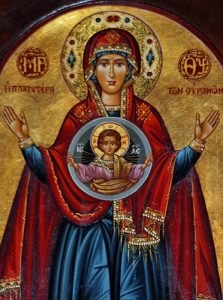 The second image is that of Mary of the Sign. Here is the Mother of God with a medallion positioned over her chest. Inside the medallion is an image of a very mature for His years Christ Child with His right hand raised in the gesture of blessing. It summarizes the Mother of God’s life from the moment of the Annunciation to eternity. She was not just the Mother of Jesus. The Mother of God needed salvation as any one of us. Her life was Christ centered and Christ filled. Mary was and is the Mother of God because she internalized Christ’s message throughout her entire life. The icon of the Sign is a constant reminder that the source of all holiness is Christ, the Son of God and our Savior.
The second image is that of Mary of the Sign. Here is the Mother of God with a medallion positioned over her chest. Inside the medallion is an image of a very mature for His years Christ Child with His right hand raised in the gesture of blessing. It summarizes the Mother of God’s life from the moment of the Annunciation to eternity. She was not just the Mother of Jesus. The Mother of God needed salvation as any one of us. Her life was Christ centered and Christ filled. Mary was and is the Mother of God because she internalized Christ’s message throughout her entire life. The icon of the Sign is a constant reminder that the source of all holiness is Christ, the Son of God and our Savior.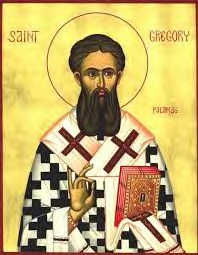 I have been sharing St. Gregory’s thoughts about the “mystery and wonder of the Trinity.” Indeed it is the one dogma – the Trinity – that makes our Christian religion so very different from other religions. It is an idea about God that retains the idea of ONE GOD Who is also THREE DISTINCT PERSONS. And, as I have repeatedly stated, it is the one understanding of God that directly connects us humans to God since the Son, the Second Person, was incarnate as a human person and still retains a glorified body. He did not stop being the GOD-MAN after his death and resurrection.
I have been sharing St. Gregory’s thoughts about the “mystery and wonder of the Trinity.” Indeed it is the one dogma – the Trinity – that makes our Christian religion so very different from other religions. It is an idea about God that retains the idea of ONE GOD Who is also THREE DISTINCT PERSONS. And, as I have repeatedly stated, it is the one understanding of God that directly connects us humans to God since the Son, the Second Person, was incarnate as a human person and still retains a glorified body. He did not stop being the GOD-MAN after his death and resurrection.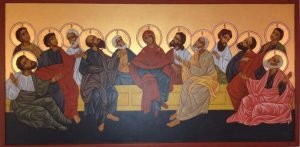 Our first reading this weekend is again taken from St. Paul’s Letter to the Romans. In the portion we hear, Paul is considering Israel’s failure to accept Christ from the standpoint of God: it does not mean that God’s promises have failed, nor that this was not foreseen by Him in His gratuitous election of Israel.
Our first reading this weekend is again taken from St. Paul’s Letter to the Romans. In the portion we hear, Paul is considering Israel’s failure to accept Christ from the standpoint of God: it does not mean that God’s promises have failed, nor that this was not foreseen by Him in His gratuitous election of Israel.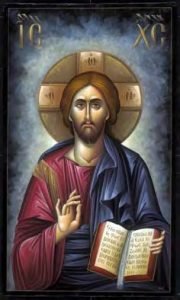 The God-Man Jesus Christ and Kenosis
The God-Man Jesus Christ and Kenosis